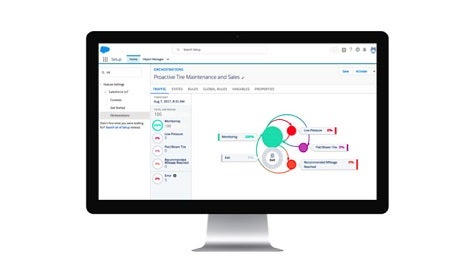The rise of the Internet of Things (IoT) has created an enormous amount of interest across a broad range of vertical industries. But turning all that potential into a real opportunity for most businesses is a significant challenge. Salesforce today moved to address that issue with the launch of Salesforce IoT Explorer Edition, a low-code application development platform that allows data being collected from an IoT platform to be streamed into the Salesforce customer relationship management (CRM) application in a way that creates actionable intelligence.
Woodson Martin, executive vice president and general manager for Salesforce IoT, says Salesforce IoT Explorer Edition builds on the cloud platform Salesforce previously announced to aggregate and analyze data. Now, Martin says, that data can be fed into an instance of Salesforce CRM to provide sales professionals and customer service representatives with insights into issues with products deployed in the field that can instantly be compared to the status of a support issue or product warranty. Armed with that data, organizations can then decide when and how they want to proactively reach out to a customer to address a specific issue, says Martin.
“This creates a real IoT value proposition for the business,” says Martin.
Because Salesforce IoT Explorer Edition makes use of a low-code framework for developing applications, Martin says, the amount of application development expertise required to set up an application that make use of IoT data is relatively trivial. By providing that capability, Martin says, Salesforce is significantly reducing the amount of time it will take for organizations to recoup their investment in an IoT project. In fact, Martin notes one of the primary reasons any organization is going to invest in IoT in the first place is to improve the customer experience. That’s hard to accomplish without being able to compare the IoT data being collected to the status of the relationship with the customer, says Martin.
Martin says Salesforce will also be able to apply the Einstein artificial intelligence capabilities the company has developed to make recommendations based on the data being collected.
Most IoT projects have yet to advance beyond the proof-of-concept stage. Getting them into actual production requires organizations to be able to attach a business model that makes sense. While a lot of that business value might be inherently obvious, the gap between tapping into all that IoT potential and delivering a service that can be monetized in one way or another is still substantial.



